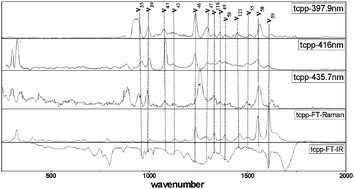Resonance Raman spectroscopy and density functional theory calculation study of photodecay dynamics of tetra(4-carboxyphenyl) porphyrin†
Abstract
The 397.9 nm, 416.0 nm and 435.7 nm resonance

* Corresponding authors
a Department of Chemistry and State Key Laboratory of advanced Textiles Materials and Manufacture Technology, MOE, Zhejiang Sci-Tech University, Hangzhou 310018, China
b
Engineering Research Center for Eco-dyeing and Finishing of Textiles, MOE, Zhejiang Sci-Tech University, Hangzhou 310018, China
E-mail:
zdwhg@163.com, zhengxuming126@126.com
Fax: 00186-571-8684-3627
Tel: 00186-571-8684-3627
c Department of Chemistry, The University of Hong Kong, Pokfulam Road, Hong Kong S.A.R., P. R. of China
The 397.9 nm, 416.0 nm and 435.7 nm resonance

 Please wait while we load your content...
Something went wrong. Try again?
Please wait while we load your content...
Something went wrong. Try again?
J. Wan, H. Wang, Z. Wu, Y. C. Shun, X. Zheng and D. L. Phillips, Phys. Chem. Chem. Phys., 2011, 13, 10183 DOI: 10.1039/C0CP02933E
To request permission to reproduce material from this article, please go to the Copyright Clearance Center request page.
If you are an author contributing to an RSC publication, you do not need to request permission provided correct acknowledgement is given.
If you are the author of this article, you do not need to request permission to reproduce figures and diagrams provided correct acknowledgement is given. If you want to reproduce the whole article in a third-party publication (excluding your thesis/dissertation for which permission is not required) please go to the Copyright Clearance Center request page.
Read more about how to correctly acknowledge RSC content.
 Fetching data from CrossRef.
Fetching data from CrossRef.
This may take some time to load.
Loading related content
